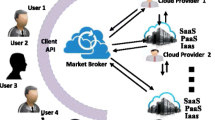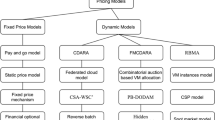Abstract
Currently, interoperability and scalability are two major challenging issues for cloud computing. Forming a dynamic collaboration (DC) platform among cloud providers (CPs) can help to better address these issues. A DC platform can facilitate expense reduction, avoiding adverse business impacts and offering collaborative or portable cloud services to consumers. However, there are two major challenges involved in this undertaking; one is to find an appropriate market model to enable a DC platform, and the other one is to minimize conflicts among CPs that may occur in a market-oriented DC platform. In this paper, we present a novel combinatorial auction (CA)-based cloud market (CACM) model that enables a DC platform in CPs. To minimize conflicts among CPs, a new auction policy is proposed that allows a CP to dynamically collaborate with suitable partner CPs to form groups and publishes their group bids as a single bid to compete in the auction. However, identifying a suitable combination of CP partners to form the group and reduce conflicts is a NP-hard problem. Hence, we propose a promising multi-objective (MO) optimization model for partner selection using individual information and past collaborative relationship information, which is seldom considered. A multi-objective genetic algorithm (MOGA) called MOGA-IC is proposed to solve the MO optimization problem. This algorithm is developed using two popular MOGAs, the non-dominated sorting genetic algorithm (NSGA-II) and the strength pareto evolutionary genetic algorithm (SPEA2). The experimental results show that MOGA-IC with NSGA-II outperformed the MOGA-IC with SPEA2 in identifying useful pareto-optimal solution sets. Other simulation experiments were conducted to verify the effectiveness of the MOGA-IC in terms of satisfactory partner selection and conflict minimization in the CACM model. In addition, the performance of the CACM model was compared to the existing CA model in terms of economic efficiency.















Similar content being viewed by others
References
Weiss A (2007) Computing in the clouds. netWorker 11(4):16–25
Interoperability (2009) A key challenge for cloud computing. http://www.lightreading.com/document.asp?doc_id=172033
Buyya R, Yeo CS, Venugopal S et al (2009) Cloud computing and emerging IT platforms: vision, hype, and reality for delivering computing as the 5th utility. Future Gener Comput Syst 25:599–616
Yamazaki Y (2004) Dynamic collaboration: the model of new business that quickly responds to changes in the market through “The integrated IT/Network Solutions” provided by NEC. NEC Journal of Advanced Technology 1(1):9–16
Bubendorfer, K. (2006) Fine grained resource reservation in open grid economies. In: Proceedings of the second IEEE international conference on e-science and grid computing, vol. 1, pp. 81–81
Bubendorfer, K, Thomson, W. (2006) Resource management using untrusted auctioneers in a grid economy. In: Proceedings of the second IEEE international conference on e-science and grid computing, vol. 1, pp. 74–74
Das A, Grosu D (2005) Combinatorial auction-based protocol for resource allocation in grid. In: Proceedings of the 19th IEEE international parallel and distributed processing symposium
Nepal, S., Zic, J. (2008) A conflict neighboring negotiation algorithm for resource services in dynamic collaboration. In: Proceedings of the IEEE international conference on services computing, vol. 2, pp. 7–11
Nepal, S., Zic, J., Chan, J. (2007) A distributed approach for negotiating resource contributions in dynamic collaboration. In: Proceedings of the 8th IEEE international conference on parallel and distributed computing applications and technologies, vol. 1, pp. 82–86
Ko CS, Kim T, Hwang H (2001) External partner selection using tabu search heuristics in distributed manufacturing. Int J Prod Res 39(17):3959–3974
Wu NQ, Su P (2005) Selection of partners in virtual enterprise paradigm. Robot Comput-Integr Manuf 21(5):119–131
Wang Z-J, Xu X-F et al (2009) Genetic algorithms for collaboration cost optimization-oriented partner selection in virtual enterprises. Int J Prod Res 47(4):859–881
Buyukozkan G, Feyzioglu O, Nebol E (2008) Selection of the strategic alliance partner in logistics value chain. Int J Prod Econ 113:148–158
Ip WH, Huang M, Yung KL et al (2003) Genetic algorithm solution for a risk-based partner selection problem in a virtual enterprise. Comput Oper Res 30:213–231
Fuqing Z, Yi H, Dongmei Y (2008) A multi-objective optimization model of the partner selection problem in a virtual enterprise and its solution with genetic algorithms. Int J Adv Manuf Technol 37:1220
Cheng F, Ye F, Yang J (2009) Multi-objective optimization of collaborative manufacturing chain with time-sequence constraints. Int J Adv Manuf Technol 40:1024–1032
Chen YL, Cheng LC, Chuang CN (2008) A group recommendation system with consideration of interactions among group members. Expert Syst Appl 34:2082–2090
Sha DY, Che ZH (2005) Virtual integration with a multi-criteria partner selection model for the multi-echelon manufacturing system. Int J Adv Manuf Technol 25:793–802
Amid A, Ghodsypour SH, Brien CO (2006) Fuzzy multi-objective linear model for supplier selection in a supply chain. Int J Prod Econ 104:394–407
Chang SL, Wang RC et al (2006) Applying fuzzy linguistic quantifier to select supply chain partners at different phases of product life cycle. Int J Prod Econ 100:348–359
Chen HH, Lee AHI, Tong Y (2007) Prioritization and operations NPD mix in a network with strategic partners under uncertainty. Expert Syst Appl 33:337–346
Saen RF (2007) Supplier selection in the presence of both cardinal and ordinal data. Eur J Oper Res 183:741–747
Huang XG, Wong YS, Wang JG (2004) A two-stage manufacturing partner selection framework for virtual enterprises. Int J Comput Integr Manuf 17(4):294–304
Gupta P, Nagi R (1995) Optimal partner selection for virtual enterprises in agile manufacturing. http://www.acsu.buffalo.edu/nagi/pubs/pgupta2.ps
Fischer M, Jahn H, Teich T (2004) Optimizing the selection of partners in production networks. Robot Comput-Integr Manuf 20(5):593–601
Kaya M (2009) MOGAMOD: multi-objective genetic algorithm for motif discovery. Expert Syst Appl 36:2
Cowan R, Jonard N et al (2007) Bilateral collaboration and the emergence of innovation networks. Manage Sci 53:1051–1067
Deb K, Pratap A, Agarwal S et al (2002) A fast and elitist multi-objective genetic algorithm: NSGA-II. IEEE Trans Evol Comput 6:182–197
Zitzler E, Laumanns M, Thiele L (2001) SPEA2: improving the strength Pareto evolutionary algorithm.TIK Report no. 103, Swiss Federal Institute of Technology
Grosu, D., Das, A (2004). Auction-based resource allocation protocols in grids. In: Proceedings of the 16th IASTED international conference on parallel and distributed computing and systems, vol. 1, pp. 20–27
Wolski R, Plank JS, Brevik J, Bryan T (2001) Analyzing market-based resource allocation strategies for the computational grid. Int J High Perform Comput Appl 15(3):258–281
Chen, S., Nepal, S., Wang, C., Zic. J. (2008) Facilitating dynamic collaborations with eContract services. In: Proceeding of 2008 IEEE international conference on Web services, vol. 1, pp. 521–528
Suzuki, K., Yokoo, M. (2003) Secure generalized Vickery auction using homomorphic encryption. In: Proceedings of 7th international conference on financial cryptography, LNCS, Springer, vol. 2742, pp. 239–249
Yokoo, M., Suzuki, K. (2002) Secure multi-agent dynamic programming based on homomorphic encryption and its application to combinatorial auctions. In: Proceedings of the first joint international conference on autonomous agents and multi-agent systems, vol. 1, ACM Press, pp. 112–119
Hwang CL, Yoon K (1981) Multiple attribute decision making: methods and applications. Springer, Berlin
Acknowledgments
This work is supported by the MKE (The Ministry of Knowledge Economy), Korea, under the ITRC (Information Technology Research Center) support program supervised by the NIPA (National IT Industry Promotion Agency) (NIPA-2010-(C1090-1011-0001)).Corresponding author is Eui-Nam Huh.
Author information
Authors and Affiliations
Corresponding author
Rights and permissions
About this article
Cite this article
Hassan, M.M., Song, B. & Huh, EN. A market-oriented dynamic collaborative cloud services platform. Ann. Telecommun. 65, 669–688 (2010). https://doi.org/10.1007/s12243-010-0184-0
Received:
Accepted:
Published:
Issue Date:
DOI: https://doi.org/10.1007/s12243-010-0184-0




